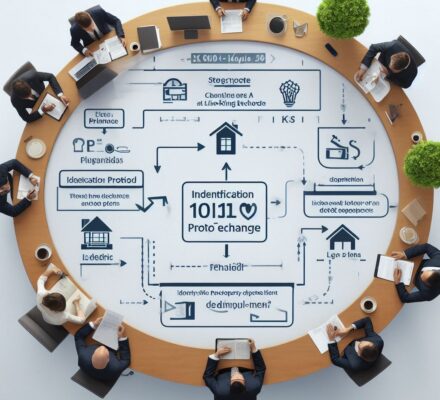Are you a savvy investor looking to maximize your profits? Then listen up, because we’ve got the essential 1031 exchange rules that you need to know.
Picture this: you sell a property and use the proceeds to invest in a new one, all while deferring taxes. Sounds like a dream, right? Well, it’s possible with a 1031 exchange.
But beware, there are important time limits, identification requirements, and restrictions to be aware of.
Stay tuned to learn more!
Key Takeaways
- Time limits for initiating and completing a 1031 exchange include 45 calendar days to identify potential replacement properties and 180 calendar days to complete the exchange.
- There are requirements for identifying replacement properties, such as the Three Property Rule, 200% Rule, and 95% Exception.
- Like-kind properties are determined by the nature or character, not quality or value.
- There are restrictions on personal use of the exchanged property, including limited personal use for a short period and renting to family members at fair market value.
Time Limits for Initiating and Completing a 1031 Exchange
First, you must understand the time limits for initiating and completing a 1031 exchange. When it comes to a 1031 exchange, time is of the essence. From the moment you sell your relinquished property, you have 45 calendar days to identify potential replacement properties. During this identification period, you must provide a written notice to a qualified intermediary specifying the properties you intend to acquire. Keep in mind that the identification must be in writing and signed by you.
Once the identification period is over, you have a total of 180 calendar days to complete the exchange. This includes both the identification period and the closing period. The countdown starts from the date of closing on the relinquished property. It’s important to note that weekends and holidays are included in these time limits.
It is crucial to adhere to these time limits to ensure a successful 1031 exchange. Failure to meet the deadlines could result in disqualification, leading to potential tax liabilities. Therefore, it’s recommended to work closely with a qualified intermediary and seek professional guidance to navigate the complexities of the 1031 exchange process.
Requirements for Identifying Replacement Properties
To successfully complete a 1031 exchange, you need to meet the requirements for identifying replacement properties within the specified time limits. This is an important step in the 1031 exchange process, as it allows you to defer your capital gains tax by reinvesting the proceeds from the sale of your original property into a new property. Here are the key requirements for identifying replacement properties:
| Requirement | Description |
|---|---|
| Three Property Rule | You can identify up to three potential replacement properties, regardless of their market value. |
| 200% Rule | You can identify more than three properties, as long as their total fair market value does not exceed 200% of the fair market value of the property you sold. |
| 95% Exception | If you identify more than three properties with a total value exceeding 200%, you must acquire at least 95% of the value of the identified properties. |
It’s important to note that once you have identified replacement properties, you cannot change your selection unless you meet certain conditions. You must provide a written notice to your qualified intermediary, who will then document the identification and keep it on file. The identification must typically be made within 45 days of the sale of your original property.
Understanding the Definition of Like-Kind Properties
Once you have successfully identified your replacement properties, it’s crucial for you to understand the definition of like-kind properties in order to proceed with your 1031 exchange. Like-kind properties refer to properties that are of the same nature or character, even if they differ in grade or quality. This means that you can exchange one type of investment property for another, as long as they’re both real property held for investment or business purposes.
For example, you can exchange a residential rental property for a commercial property, or a vacant land for an industrial property.
However, there are certain limitations when it comes to like-kind properties. For instance, personal residences, second homes, and vacation properties don’t qualify as like-kind properties for a 1031 exchange. Additionally, properties located outside of the United States can’t be considered like-kind properties for the purpose of a 1031 exchange.
It is important to note that the definition of like-kind properties applies to the nature or character of the property, not its quality or value. This means that you can exchange a property of lower value for one of higher value, as long as they’re both of the same nature or character.
Understanding the definition of like-kind properties is essential as it determines the eligibility of the properties you intend to exchange in your 1031 exchange. By ensuring that your replacement property qualifies as a like-kind property, you can move forward with your exchange and enjoy the tax benefits it offers.
Restrictions on Personal Use of the Exchanged Property
Make sure to adhere to the restrictions on personal use of the exchanged property during your 1031 exchange. The Internal Revenue Service (IRS) has established clear guidelines to ensure that the property being exchanged is used solely for investment or business purposes. Failure to comply with these restrictions can result in disqualification of the exchange and potential tax consequences.
To help you understand these restrictions better, let’s take a look at the following table:
| Personal Use Restrictions | Explanation |
|---|---|
| No personal use of the property | You cannot use the exchanged property for personal purposes such as a vacation home or primary residence. It must be used exclusively for investment or business purposes. |
| Limited personal use for a short period | The IRS allows for limited personal use of the property, but only for a period of 14 days or 10% of the total number of days the property is rented out, whichever is greater. This means you can enjoy a short vacation or use the property for personal reasons, as long as it doesn’t exceed the allowed time frame. |
| Renting to family members | Renting the exchanged property to family members is generally prohibited. However, there are exceptions if the rental is conducted at fair market value and the family member does not use the property for personal purposes. It’s important to consult with a tax professional to ensure compliance with the IRS regulations. |
| Prohibition on self-use | You cannot use the exchanged property for your own business activities. It must be rented out to another party for business purposes. This restriction prevents individuals from exchanging their personal property for business property and then using it for their own benefit. It ensures the integrity of the 1031 exchange process as a tool for investment and business growth. |
Reporting and Documentation Obligations for a 1031 Exchange
Ensure compliance with the IRS regulations by fulfilling your reporting and documentation obligations for a 1031 exchange. As an investor, it’s crucial to understand the importance of accurate reporting and proper documentation when engaging in a 1031 exchange. By doing so, you can avoid any potential penalties or disputes with the IRS.
To fulfill your reporting obligations, you’re required to report the exchange on your tax return for the year in which the exchange occurs. This includes providing details such as the description of the relinquished property, the date of the exchange, and the identification of the replacement property. By accurately reporting this information, you can demonstrate your compliance with the IRS regulations.
Documentation is equally important in a 1031 exchange. You must maintain records that support the exchange, including documents such as purchase agreements, settlement statements, and closing documents for both the relinquished and replacement properties. These documents serve as evidence of the exchange and can be crucial in case of an IRS audit.
Remember, the burden of proof rests on you as the investor to substantiate the exchange. Therefore, it’s essential to keep all relevant documentation organized and readily accessible for at least six years.
Frequently Asked Questions
Can I Use a 1031 Exchange to Defer Taxes on the Sale of a Primary Residence?
No, you cannot use a 1031 exchange to defer taxes on the sale of a primary residence. This tax strategy is specifically for investment properties and requires strict adherence to the rules.
Can I Do a 1031 Exchange With a Property Located in a Different State?
Yes, you can do a 1031 exchange with a property located in a different state. It allows you to defer taxes on the sale of your property by exchanging it for a like-kind property.
Is There a Limit to the Number of Replacement Properties I Can Identify in a 1031 Exchange?
Yes, there is a limit to the number of replacement properties you can identify in a 1031 exchange. The IRS allows you to identify up to three properties, regardless of their value or location.
Can I Exchange a Property Held in a Trust Through a 1031 Exchange?
Yes, you can exchange a property held in a trust through a 1031 exchange. However, there are certain rules and requirements that need to be followed regarding the trust structure and ownership.
Are There Any Penalties for Not Meeting the Time Limits in a 1031 Exchange?
If you don’t meet the time limits in a 1031 exchange, you could face penalties. It’s crucial to stay within the deadlines to avoid any potential consequences. Stay on top of the rules!




